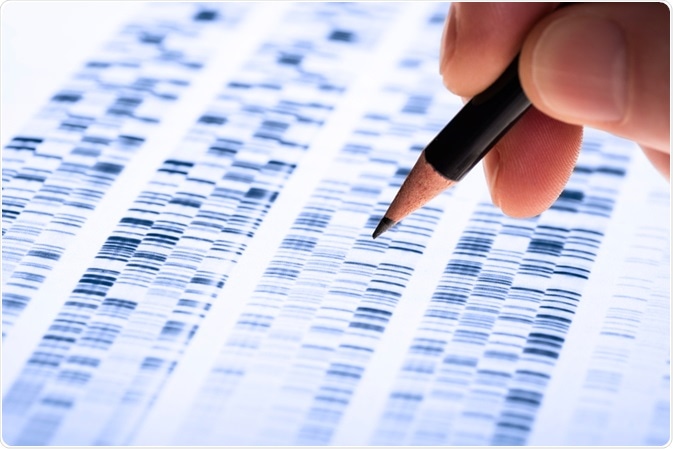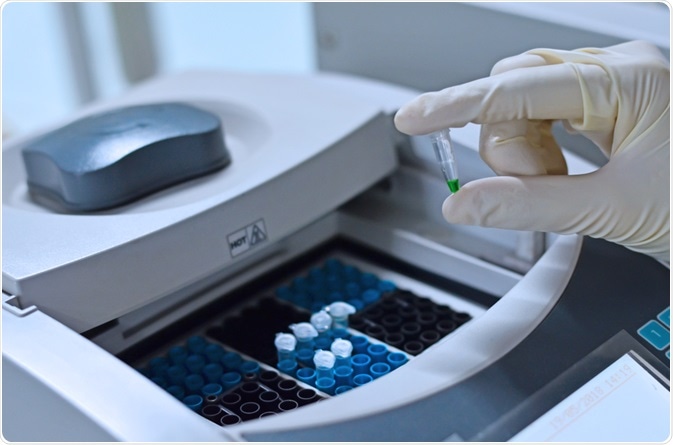DNA profiling is a standard analytical technique used in forensic investigations to assist in the identification of deceased individuals.

Image Credit: gopixa/Shutterstock.com
How does DNA profiling work?
It is estimated that human beings are 99.9% identical in their genetic makeup and that the remaining 0.1% of the human genome contains regions of variation. These noncoding regions contain repeating units of DNA that vary in length between each individual.
One type of DNA repeat includes short tandem repeats (STRs) or microsatellites, which are between two and seven bases in length and will be repeated a variable number of times in different individuals. As more of these regions are analyzed, the likelihood that two unrelated individuals will have the same number of STRs goes down significantly.
Sample types
Nearly every cell within the human body contains DNA; therefore, DNA can be extracted from several different types of biological samples to identify deceased individuals. The preferred sample type for DNA profiling is blood; however, in cases where the human remains are decomposed, this sample type is not available.
An additional limitation for blood collection during external autopsies is the need to invasively open the body. This procedure can increase the chance of needle stick injury to the forensic pathologist, as well as potentially expose the forensic professionals to a wide range of pathogens and/or infectious diseases.
Bone
Another valuable source of DNA material is bone, as its hard structure can protect DNA from degradation for longer periods. Despite these advantages, the collection of bone samples requires invasive surgical procedures, which often require the use of saws, of the deceased to be performed.
Therefore, like blood sample collection, certain occupational health and safety risks are associated with the collection of bone samples.
Dental tissues
Due to the limitations associated with collecting post-mortem blood and bone samples, several alternatives and less invasive sample types can also be used for DNA profiling.
Another excellent source of DNA material includes dental tissues, which are resistant to environmental assaults such as incineration, immersion, trauma, mutilation, and decomposition. Dental identifications of individuals have therefore played a key role in many mass disasters like bombings, earthquakes, hurricanes, and air crashes.
Nails
Nail material can also be used as a source of DNA material to identify an individual from decomposed remains. Since nails, like bones, are composed of hard biological materials, they are often resistant to degradation and other types of damage from environmental factors.
Furthermore, the collection of nails is easy and non-invasive, thereby limiting exposure risks to the forensic investigator. Moreover, DNA extraction from nail material can also be completed in less time, which allows forensic investigators and other legal personnel to provide information to the public and worried family members in a timely manner.
PCR for DNA profiling
The analysis of STRs within forensics for identification purposes is otherwise known as DNA profiling, which is one of the most common DNA technologies used within this field. Any type of DNA profiling assay will target multiple STR loci that are located across autosomal chromosomes and/or the X or Y chromosomes, which are more commonly known as the sex chromosomes.
Since STRs are flanked by known sequences that are often uniform throughout the population, the analytical technique of polymerase chain reaction (PCR) is often used for DNA profiling. PCR amplifies STRs present between the flanking sequences to levels that are sufficient for analysis, thereby allowing researchers to determine the two lengths of any STR present within an individual’s genome.
Within the United States, the Combined DNA Index System (CODIS) is maintained by the U.S. Federal Bureau of Investigation (FBI). The CODIS currently contains records of core STR markers for over 10 million people and this number is expected to rise as more samples are obtained.
For STR evidence to be admissible during a criminal trial in the U.S., it must contain information on the frequency of each allele of each of the 13 core STRs that naturally occur in people of all races.
The 13-STR Profile system is highly robust in that the likelihood that an individual who is unrelated to the actual perpetrator has a 1 in 1 billion chance of being a perfect match for all 13 autosomal STR loci.

Image Credit: Kallayanee Naloka/Shutterstock.com
Direct PCR approach
One type of specific PCR technique that is gaining popularity for its DNA profiling capabilities is the direct PCR approach. The direct PCR approach eliminates the need to extract and quantify DNA before the analysis, and instead allows forensic investigators to directly analyze their samples in a PCR-based assay. The sample type and/or kit being used can determine the exact methodology for a given direct PCR approach.
Recently in South Africa, in an attempt to identify a growing number of unidentified bodies, researchers utilized buccal samples collected from the human remains to test the utility of a direct PCR approach for DNA profiling. In their work, full DNA profiles were obtained from 73% of all collected post-mortem buccal lysates.
Although the buccal samples required an increased lysate input to achieve an optimal DNA profile success rate, this study proved that this type of sample could ease the human identification workflow in various post-mortem settings.
References and Further Reading
- Norrgard, K. (2008). Forensics, DNA Fingerprinting, and CODIS. Nature Education 1(1):35. Accessed on 14 September 2020. https://www.nature.com/scitable/topicpage/forensics-dna-fingerprinting-and-codis-736/.
- Reid, K. M., & Heathfield, L. J. (2020). Evaluation of direct PCR for routine DNA profiling of non-decomposed deceased individuals. Science & Justice. doi:10.1016/j.scijus.2020.08.004.
- Manjunath, B. C., Chandrashekar, B. R., Mahesh, M., et al. (2011). DNA profiling and forensic dentistry – A review of the recent concepts and trends. Journal of Forensic and Legal Medicine 18(5); 191-197. doi:10.1016/j.jflm.2011.02.005.
- Schlenker, A., Grimble, K., Azim, A., et al. (2016). Toenails as an alternative material for the extraction of DNA from decomposed human remains. Forensic Science International 258; 1-10. doi:10.1016/j.forsciint.2015.10.025.
Further Reading
Last Updated: Oct 21, 2020